Joubert Syndrome: The Molar Tooth Sign of the Mid‑Brain
- *Corresponding Author:
- Dr. Chiranjib Nag
Department of General Medicine, Burdwan Medical College and Hospital, Burdwan, West Bengal, India
E-mail: dr.chiranjib.nag@gmail.com
Abstract
Joubert syndrome (JS) is a very rare, autosomal‑recessive condition. It is characterized by agenesis of cerebellar vermis, abnormal eye movements with nystagmus, episodes of hyperpnea and apnea, delayed generalized motor development, retinal coloboma and dystrophy and, sometimes, multicystic kidney disease. The importance of recognizing JS is related to the outcome and its potential complications. Prenatal diagnosis by ultarsonography and antenatal magnetic resonance imaging (MRI) is also possible. We have diagnosed a case of JS in a male infant with history of delayed mental and motor milestone development, history of abnormal breathing pattern, abnormal limb movement, generalized hypotonia and abnormal head movements with nystagmus. MRI showed hypoplastic cerebellar vermis with hypoplasia of the superior cerebellar peduncle resembling the ``Molar Tooth Sign`` in the mid‑brain.
Keywords
Joubert syndrome, Molar tooth sign, Vermian agenesis
Introduction
Joubert syndrome (JS) is a very rare, autosomal-recessive condition, first described by Joubert in 1969. We were able to diagnose a case of JS in our institution in a 1 year 4 month-old male baby born of consanguineous marriage. This syndrome has been rarely reported elsewhere in the world, including India. The estimated incidence rate is 1 in 80,000 to 1 in 1,00,000 live births.[1] This is one of the very few reported cases associated with consanguineous marriage. Because of the rarity of this case, we are reporting this case in this prestigious journal.
Case Report
A 1 year and 4 month-old male baby was admitted in our department with history of delayed developmental milestone, mental retardation, abnormal limb movement, generalized hypotonia and abnormal head movements with nystagmus. There was also history of abnormal breathing pattern with episodes of alternate rapid breathing and normal breathing. There was history of feeding difficulties on and off and frequent chest infection from the early months of life.
Past history revealed that the child was born by normal vaginal delivery in a hospital at term pregnancy, with history suggestive of birth asphyxia. The birth weight of the baby was 3 kg. His parents had a consanguineous marriage. From the early days of life, his mother noticed feeding difficulties and frequent chest infections of her baby. She also noticed abnormal movement of his head and peculiar eye movement with deviation of the eyes, but relative paucity of movement of the limbs. There was history of episodic rapid breathing lasting for 2-3 min with frequent opening of the mouth and protrusion of the tongue interspersed with normal breathing. There was weak cry and floppiness of all the muscles from the first few months of life. But, no convulsion was noted. Hearing was normal as the child was able to turn the head toward the source of sound. Symptoms were progressively increasing. Prenatal history was uneventful. No similar illness in any siblings in the family was reported. Immunization was incomplete. There was gross delay in development of mental and motor milestones.
Physical examination revealed a hypotonic child with constant efforts of abnormal head movement sideways and limb movements, opened mouth with protruded tongue [Figure 1], and the child showed abnormal breathing pattern with hyperpnea and tachypnea. Head circumference and other anthropometric examinations were normal. No morphological abnormality was detected. Cardiovascular and respiratory system examinations were normal. No organomegaly was present. Ocular examinations revealed bilateral divergent squint, inability to follow moving object, restricted upward gaze of eye and bilateral horizontal gaze-evoked nystagmus. Retinoscopy revealed refractory error of both eyes. Ophthalmoscopic examination was normal and no pigment changes in the retina were detected; optic disc was also normal. Complete blood count, renal function test and liver function test were normal.
Imaging findings
Axial T1- and T2-weighted magnetic resonance imaging (MRI) images showed hypoplastic cerebellar vermis with hypoplasia of the superior cerebellar peduncle resembling the “Molar Tooth Sign” in the mid-brain [Figures 2 and 3]. MRI sagital T1-weighted image revealed partial agenesis of cerebellum agenesis and hypoplasia of the superior cerebeller peduncle was noted [Figure 4]. MRI axial (at the level of post-fossa) T2-weighted image revealed hyperintensity of basal cisterns communicating with the fourth ventricle suggestive of vermian agenesis [Figure 5]. Renal ultrasound showed no abnormality.
Discussion
JS is inherited as an autosomal-recessive disorder, and very few cases have been reported in the world. Both parents are the carriers of the gene. Parents who have a child with JS have a 25% chance of transmission of this disorder in subsequent pregnancy. Prenatal testing with targeted ultrasound may be a mode of investigation to detect prenatally. This syndrome was named after the French neurologist who first described that the clinical findings of S consist of abnormal eye movements with nystagmus and inability of smooth pursuit of a moving object, episodes of hyperpnea and apnea and delayed generalized motor development.[1,2]
There may be hydrocephalus, cystic enlargement of posterior fossa, hypothalamic hamartoma and absence of pituitary gland.[3] Eye involvement may range from congenital blindness to retinal dystrophy and unilateral or bilateral coloboma of retinal pigment epithelium.[4] Kidney involvement may occur in the form of cystic dysplasia, juvenile nephronophthisis and tubulointerstitial nephritis. Others important features are congenital hepatic fibrosis, polydactyly and thyroid hormone dysfunction.[5]
This multiorgan involvement and pleotropic character is probably due to its genetic foci. At least 10 genes have been identified to be causative of JS-related disorder, like INPP5E, NPHP1, AHI, CEP290 and 1CC2D2A.[6,7] All these genes code for protein of primary cilium. Defective cilia are malfunctioning in the retina, renal tubule and neural cell migration thus producing heterogeneous syndrome complexs known as “ciliopathies.” Other ciliopathies like Senior-Loken syndrome, Bardet Biedl syndrome and isolated nephronopthisis must be considered as the differential diagnosis of JS.
The main imaging findings, present almost uniformly, are partial or complete absence of the cerebellar vermis, hypoplastic cerebellar peduncles and fourth ventricular deformity.[8] Cerebellar hemispheres are usually normal. The cerebrum is not affected, although moderate lateral ventricular enlargement due to atrophy was described in 6-20% of the cases, and corpus callosum dysgenesis was present in 6-10% of the cases.[8] In our reported case, no supratentorial abnormality was present.
Partial or complete absence of the cerebellar vermis has been described as an isolated anomaly or as a part of Dandy-Walker syndrome, Down syndrome or JS.[9] In patients with Dandy-Walker syndrome, there is a cyst in the posterior fossa that leads to expansion of the posterior fossa. The absence of vermis leads to a midline cleft between the cerebellar hemispheres. The combination of hypoplasia of the cerebellar peduncles resulting in molar tooth sign and severe hypoplasia of the vermis resembling bat-wing appearance of the fourth ventricle in the MRI are highly suggestive of JS.[10] Molar tooth sign is not specific for JS. This may be seen in Varadi-Papp syndrome, Malta syndrome, Senior-Loken syndrome and COACH syndrome.[7]
The importance of recognizing JS is related to its outcome. Retinal dysplasia is highly correlated with renal cystic disease, and seems to carry a worse prognosis in terms of survival.[11] Retinal dysplasia is often difficult to diagnose early; therefore, regular ocular screening should be performed. In patients with retinal anomalies, it is also advisable to monitor renal function and perform ultrasonography (US) of the kidneys to detect cystic renal disease.[11] Patients with JS are extremely sensitive to the respiratory depressant effects of anesthetic agents such as opioids and nitrous oxide and susceptible to post-operative respiratory infection.[12] Therefore, these agents should be avoided, and close perioperative respiratory monitoring and care are essential.
Genetic counseling is important in a family having JS. Mutation screening of known gene mutation can pick up less than 50% of the cases.[13] Furthermore, once a diagnosis of JS is made in one neonate, the diagnosis of JS can be made antenatally by looking for the imaging findings at antenatal US of the fetal brain in a subsequent pregnancy. Antenatal magnetic resonance can also pick up JS carefully.[14]
Acknowledgment
The authors are highly grateful to Prof. Shyamal Kumar Mitraniyogi, Prof. and HOD, Department of Radiodiagnoisis of this institution, for assisting in the interpretation of MRI.
References
- Parisi MA, Doherty D, Chance PF, Glass IA. Joubert syndrome (and related disorders) (OMIM 213300). Eur J Hum Genet 2007;15:511-21.
- Maria BL, Boltshauser E, Palmer SC, Tran TX. Clinical features and revised diagnostic criteria in Joubert syndrome. J Child Neurol 1999;14:583-90;discussion 590-1
- ten Donkelaar HJ, Hoevenaars F, Wesseling P. A case of Joubert’s syndrome with extensive cerebral malformations. Clin Neuropathol 2000;19:85-93.
- Sturm V, Leiba H, Menke MN, Valente EM, Poretti A, Landau K, et al. Ophthalmological findings in Joubert syndrome. Eye (Lond) 2010;24:222-5.
- Parisi MA. Clinical and molecular features of Joubert syndrome and related disorders. Am J Med Genet C Semin Med Genet 2009;151C: 326-40.
- Castori M, Valente EM, Donati MA, Salvi S, Fazzi E, Procopio E, et al. NPHP1 gene deletion is a rare cause of Joubert syndrome related disorders. J Med Genet 2005;42:e9.
- Brancati F, Dallapiccola B, Valente EM. Joubert Syndrome and related disorders. Orphanet J Rare Dis 2010;5:20.
- Patel S, Barkovich AJ. Analysis and classification of cerebellar malformations. AJNR Am J Neuroradiol 2002;23:1074-87.
- Guibaud L, des Portes V. Plea for an anatomical approach to abnormalities of the posterior fossa in prenatal diagnosis. Ultrasound Obstet Gynecol 2006;27:477-81.
- Choh SA, Choh NA, Bhat SA, Jehangir M. MRI findings in Joubert syndrome. Indian J Pediatr 2009;76:231-5.
- Saraiva JM, Baraitser M. Joubert syndrome: A review. Am J Med Genet 1992;43:726-31.
- Christina J, Steven MN. Anesthesia for a Patient with Joubert Syndrome Presenting for MRI of a Transplanted Kidney. The Internet Journal of Anesthesiology. 2007 Volume 14 Number 1. DOI: 10.5580/22bd vailable from http://www. ispub.com/journal/the-internet-journal-of-anesthesiology/ volume-14-number-1/anesthesia-for-a-patient-withjoubert-syndrome-presenting-for-mri-of-a-transplantedkidney. html
- Valente EM, Brancati F, Dallapiccola B: Genotypes and phenotypes of Joubert syndrome and related disorders. Eur J Med Genet 2008;51:1-23.
- Doherty D, Glass IA, Siebert JR, Strouse PJ, Parisi MA, Shaw DW et al. Prenatal diagnosis in pregnancies at risk for Joubert syndrome by ultrasound and MRI. Prenat Diagn 2005;25:442-7.

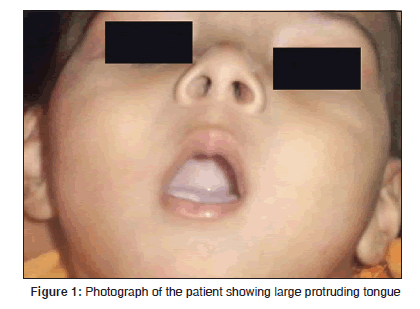
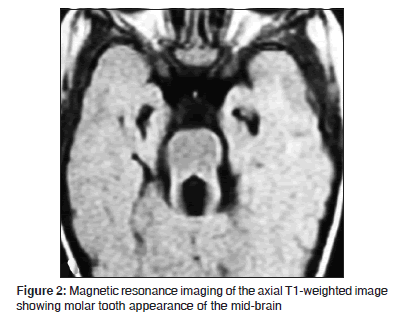
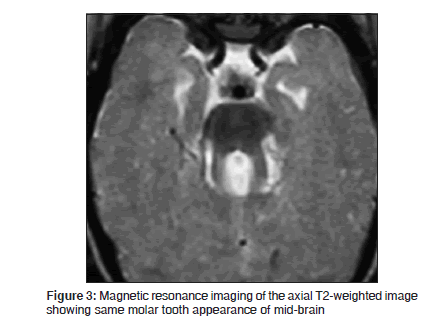

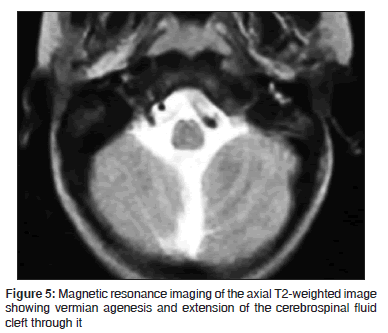


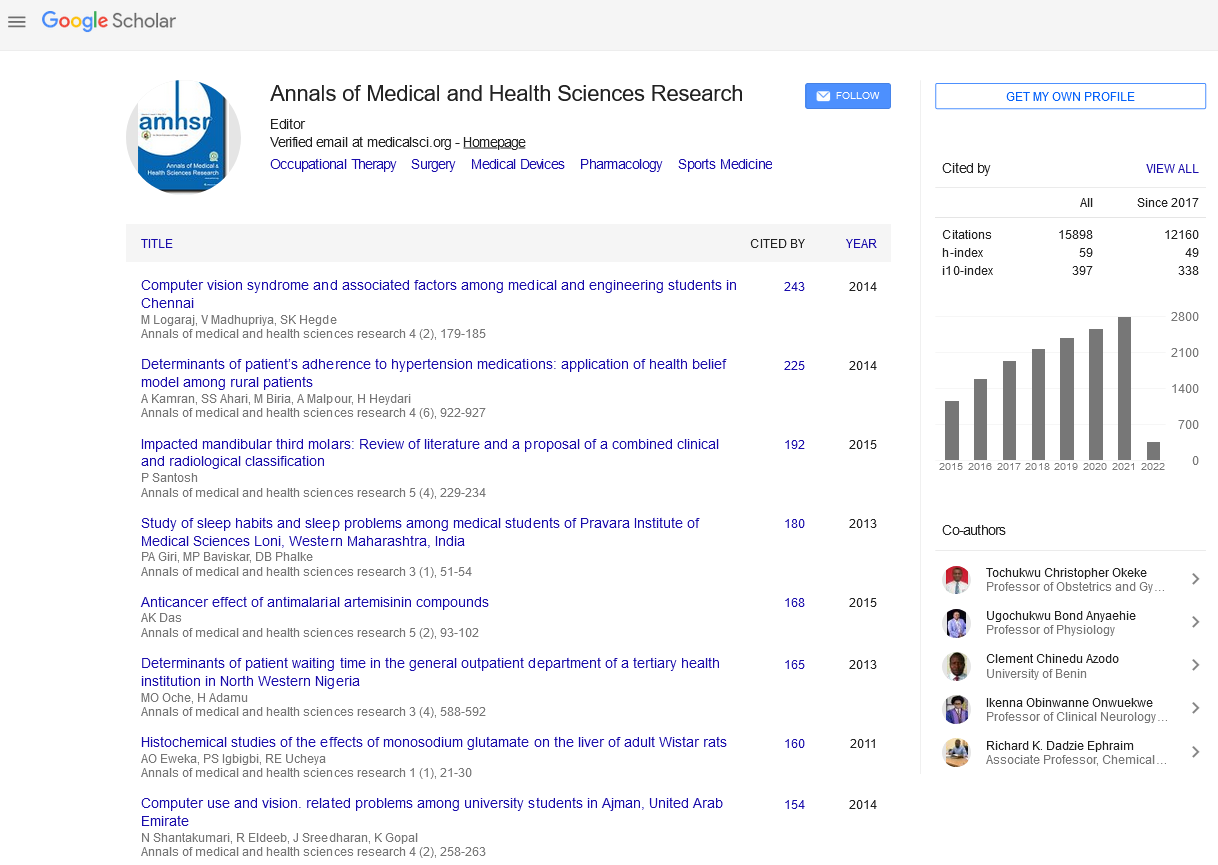

 The Annals of Medical and Health Sciences Research is a bi-monthly multidisciplinary medical journal.
The Annals of Medical and Health Sciences Research is a bi-monthly multidisciplinary medical journal.